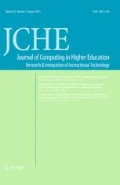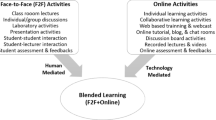Abstract
A growing and increasingly important area of research in higher education is the investigation of how different forms of support and training programs facilitate faculty adoption of technology into pedagogical practices. This study explored the implementation of a faculty technology mentoring (FTM) program as a university-wide professional development model, focusing on the success factors and critical strategies that encourage technology adoption in faculty teaching practices. The goal of this effort is to provide evidence-based discussion on an FTM model tailored to faculty members’ needs in a university context. Participants included 12 faculty members (mentees) and 12 graduate students (mentors), paired throughout the FTM program. Analysis of mentors’ weekly blog posts, case reports, and interviews with faculty members revealed six critical strategies: determining needs; exploring technologies’ affordances and limitations; scaffolding; sharing feedback; connecting technology, pedagogy, and content; and evaluating. Success factors included motivation, meeting challenges, the nature of mentoring relationships, communication channels, and support. The results point to key recommendations for higher education institutions that plan to implement similar mentoring programs in order to support technology integration into faculty members’ teaching practices.


Similar content being viewed by others
References
Adamy, P., & Heinecke, W. (2005). The influence of organizational culture on technology integration in teacher education. Journal of Technology and Teacher Education, 13(2), 233–255.
Al-Senaidi, S., Lin, L., & Poirot, J. (2009). Barriers to adopting technology for teaching and learning in Oman. Computers and Education, 53(2009), 575–590.
Baran, E., & Correia, A. P. (2014). A professional development framework for online teaching. TechTrends, 58(5), 96–102.
Beisser, S. (2000). Technology mentorships in higher education: An optimal match for expanding educational computing skills. In B. Gillan & K. McFerrin (Eds.), Faculty development (pp. 441–447). Retrieved from ERIC database (ED444497).
Bennett, J., & Bennett, L. (2003). A review of factors that influence the diffusion of innovation when structuring a faculty training program. Internet and Higher Education, 6(2003), 53–63.
Bierema, L. L., & Merriam, S. B. (2002). E-mentoring: Using computer mediated communication to enhance the mentoring process. Innovative Higher Education, 26(3), 211–227.
Buchanan, T., Sainter, P., & Saunders, G. (2013). Factors affecting faculty use of learning technologies: Implications for models of technology adoption. Journal of Computing in Higher Education, 25, 1–11.
Chuang, H., & Schmidt, D. (2008). Faculty technology mentoring programs. In A. D. Thompson, H. Chuang, & I. Sahin (Eds.), Faculty mentoring: The power of students in developing technology expertise (pp. 29–46). Charlotte, NC: Information Age Publishing.
Chuang, H., Thompson, A., & Schmidt, D. (2003). Faculty technology mentoring programs: Major trends in the literature. Journal of Computing in Teacher Education, 19(4), 101–106.
Corbin, J., & Holt, N. L. (2005). Grounded theory. In B. Somekh & C. Lewin (Eds.), Research methods in the social sciences (pp. 49–55). Thousand Oaks, CA: Sage.
Cotugna, N., & Vickery, C. (1998). Reverse mentoring: A twist to teaching technology. Journal of the American Dietetic Association, 98(10), 1166–1168.
Crisp, G., & Cruz, I. (2009). Mentoring college students: A critical review of the literature between 1990 and 2007. Research in Higher Education, 50(6), 525–545.
Dahlstrom, E., & Brooks, C. D. (2014). Study of faculty and information technology research. Louisville, CO: ECAR. Retrieved from http://www.educause.edu/library/resources/study-faculty-and-information-technology-2014.
Dawson, P. (2014). Beyond a definition: Toward a framework for designing and specifying mentoring models. Educational Researcher, 43(3), 137–145.
Ertmer, P. A. (2005). Teacher pedagogical beliefs: The final frontier in our quest for technology integration? Educational Technology Research and Development, 53(4), 25–39.
Ertmer, P. A., & Ottenbreit-Leftwich, A. T. (2013). Removing obstacles to the pedagogical changes required by Jonassen’s vision of authentic technology-enabled learning. Computers and Education, 64, 175–182.
Franklin, T., Turner, S., Kariuki, M., & Duran, M. (2001). Mentoring overcomes barriers to technology integration. Journal of Computing in Teacher Education, 18(1), 26–31.
Friel, T., Britten, J., Compton, B., Peak, A., Schoch, K., & VanTyle, W. K. (2009). Using pedagogical dialogue as a vehicle to encourage faculty technology use. Computers and Education, 53(2009), 300–307.
Gabriel, M. A., & Kaufield, K. J. (2008). Reciprocal mentorship: An effective support for online instructors. Mentoring and Tutoring: Partnership in Learning, 16(3), 311–327.
Georgina, D. A., & Hosford, C. C. (2009). Higher education faculty perceptions on technology integration and training. Computers and Education, 25, 690–696.
Georgina, D. A., & Olson, M. R. (2008). Integration of technology into higher education: A review of faculty self-perceptions. Journal of Higher Education and Technology, 11(1), 1–8.
Grant, M. (2004). Learning to teach with the web: Factors influencing teacher education faculty. The Internet and Higher Education, 7, 329–341.
Johnson, L., Adams Becker, S., Estrada, V., & Freeman, A. (2015). NMC horizon report: 2015 higher education edition. Austin, TX: The New Media Consortium.
Kealy, W. A., & Mullen, C. A. (2003). Guest editors’ introduction: At the nexus of mentoring and technology. Mentoring and Tutoring: Partnership in Learning, 11(1), 3–13.
Koehler, M. J., Mishra, P., Hershey, K., & Peruski, L. (2004). With a little help from your students: A new model for faculty development and online course design. Journal of Technology and Teacher Education, 12(1), 25–55.
Kopcha, T. J. (2008). Teachers’ perceptions of the barriers to technology integration and practices with technology under situated professional development. Computers and Education, 59(2012), 1109–1121.
Kopcha, T. J. (2010). A systems-based approach to technology integration using mentoring and communities of practice. Education Technology Research and Development, 58, 175–190.
Larson, L. (2009). A descriptive study of mentoring and technology integration among teacher education faculty. International Journal of Evidence Based Coaching and Mentoring, 7(1), 119–135.
Leh, A. S. C. (2005). Lessons learned from service learning and reverse mentoring in faculty development: A case study in technology training. Journal of Technology and Teacher Education, 13(1), 25–41.
Lincoln, Y., & Guba, E. (1985). Naturalistic inquiry. Newbury Park, CA: Sage.
Miles, M., & Huberman, A. (1994). Qualitative data analysis: An expanded sourcebook. Thousand Oaks, CA: Sage.
Mishra, P., & Koehler, M. J. (2006). Technological pedagogical content knowledge: A framework for teacher knowledge. Teachers College Record, 108(6), 1017–1054.
Mishra, P., Koehler, M. J., & Zhao, Y. (2007). Communities of designers: A brief history and introduction. In P. Mishra, M. J. Koehler, & Y. Zhao (Eds.), Faculty development by design: Integrating technology in higher education (pp. 1–22). Greenwich, CT: Information Age Publishing.
Ng, W. (2015). Adopting new digital technologies in education: Professional learning. In W. Ng (Ed.), New digital technology in education: Conceptualizing professional learning for educators (pp. 25–48). Switzerland: Springer.
Rhodes, C., Stokes, M., & Hampton, G. (2004). A practical guide to mentoring, coaching and peer-networking. London, England: RoutledgeFalmer.
Rogers, E. M. (2003). Diffusion of innovations (5th ed.). New York, NY: The Free Press.
Silva, K., Correia, A., & Pardo-Ballester, C. (2010). A faculty mentoring experience: Learning together in Second Life. Journal of Computing in Teacher Education, 26(4), 149–159.
Straub, E. T. (2009). Understanding technology adoption: Theory and future directions for informal learning. Review of Educational Research, 79(2), 625–649.
Swan, K., Holmes, A., Vargas, J. D., Jennings, S., Meier, E., & Rubenfeld, L. (2002). Situated professional development and technology integration: The capital area technology and inquiry in education (CATIE) mentoring program. Journal of Technology and Teacher Education, 10(2), 169–190.
Thompson, A. (2008). History of the faculty technology mentoring program. In A. D. Thompson, H. Chuang, & I. Sahin (Eds.), Faculty mentoring: The power of students in developing technology expertise (pp. 29–46). Charlotte, NC: Information Age Publishing.
Xu, Y., & Meyer, K. A. (2007). Factors explaining faculty technology use and productivity. Internet and Higher Education, 10(2007), 41–52.
Yin, R. K. (2009). Case study research: Design and methods. Thousand Oaks, CA: Sage.
Zhao, Y., & Cziko, G. A. (2001). Teacher adoption of technology: A perpetual control theory perspective. Journal of Technology and Teacher Education, 9, 5–30.
Author information
Authors and Affiliations
Corresponding author
Rights and permissions
About this article
Cite this article
Baran, E. Investigating faculty technology mentoring as a university-wide professional development model. J Comput High Educ 28, 45–71 (2016). https://doi.org/10.1007/s12528-015-9104-7
Published:
Issue Date:
DOI: https://doi.org/10.1007/s12528-015-9104-7




